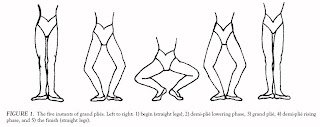Jazz Terminology
Axel Turn
An axel turn is a simple yet stunning jump often used in intermediate choreography. Starting with a chene turn, one leg goes up into passé, followed by the other, developing into a fully rotating jump in the air.
Ball Change
A ball change is a change of weight distribution on the balls of the feet. This is a popular transitory step in many jazz dance routines.
Chasse
Stolen from ballet, this step resembles a galloping motion, as one foot literally "chases" the other. This is often used in jazz dance terminology to describe a way to travel across the stage, or flow two moves together.
Fan Kick
The body stays in place while one leg starts inward and kicks all the way around to its original position.
Jazz Walk
Posture is low, and feet slightly drag across the floor in this modified walk used for traveling across the stage. Variations include the jazz run and jazz drag.
Knee Turn
A basic chene turn, only it is executed on one or both knees.
Layout
One leg is kicked up in the air, while the torso is leaned back into as dramatic an arch as possible. Head should be dropped back and arms should also be extended backward, almost able to touch the floor.
Pivot Step
One foot steps in front of the other, and then the body pivots around back into the original position.
Release
Following an isolated pose, the body "releases" into a freer form.
Stag Leap
A very high jump, simulating splits in the air, only one leg is bent so the foot is tucked under the knee.


